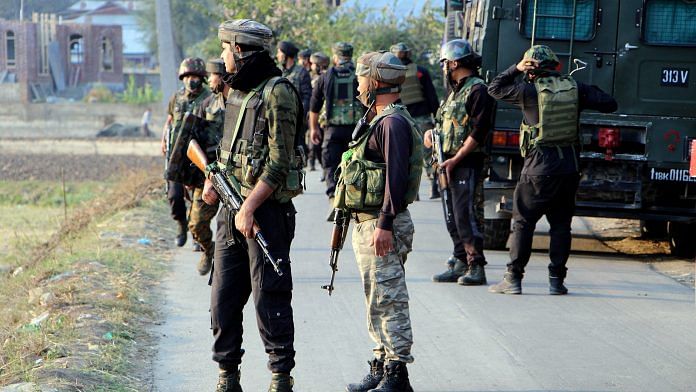
Thank you dear subscribers, we are overwhelmed with your response.
Your Turn is a unique section from ThePrint featuring points of view from its subscribers. If you are a subscriber, have a point of view, please send it to us. If not, do subscribe here: https://theprint.in/subscribe/
As per a recent media report, the government is considering withdrawing the Indian Army completely from the Kashmir Valley hinterland. The report, which was not corroborated by the government, further added that the proposal to withdraw the Army from Kashmir hinterland had been under discussion for about two years and was at an “advanced stage”. The proposal was to enable the CRPF to fill in for the army personnel removed from the Valley to meet the challenges of both law and order and counterinsurgency operations. The idea behind the deliberations is to claim normalcy in Kashmir and make it visible.
The facet of army withdrawal from Jammu and Kashmir (J&K) has often been visited in past, bringing changes on the ground. Army carried out counter-insurgency with J&K Police and the BSF till 2004-05, to be replaced by CRPF. Also in Srinagar, all counter-terror operations since 2005 are being carried out by CRPF and J&K Police, with the Army comprising Rashtriya Rifles (RR) being kept out.
Analysts have flagged that the move could be a ‘messaging’ in support of the claims of normalcy by the government. However, if the the proposal is merely a rhetoric bereft of effective changes at execution levels, it will result in a huge loss of credibility for the government; detrimental to the overall interests.
As far as benchmarking normalcy is concerned, in the last 10 years i.e., from 2012 to 2022, as per South Asia Terrorism Portal, the average number of incidents of killings per year involving militants, security personnel and civilians amount to approximately 126. This figure is lower than the number of killings in years 2019, 2020, 2021, and 2022, which stand at 135, 140, 153, and 151 respectively. Although since 2019, there has been a decline in incidents of stone pelting and tourism has picked up, declaring victory vis-a-vis restoration of normalcy would be premature.
Notwithstanding the above, in case the withdrawal is executed sooner rather than later – for sake of sustenance, it needs to be nuanced and meticulous. Given the fact that the intended measure has been a work in progress for the last two years, the government must be contemplating thorough consolidation post its implementation. In this regard, the following factors are important.
Firstly, in connection with RR, as claimed in the report, its downsizing is being mulled over. This indeed is justifiable given the backdrop of the current situation in J&K. In addition, it shall be pertinent to introduce modifications in the current mandate and role of RR from hardcore counterinsurgency to the genre of consolidation operations.
Secondly, the withdrawal of the Army from identified areas should be preceded or accompanied by improvements in sociological indices. The answer lies in greater democratisation in terms of holding elections, empowering grassroots governance, and progressing to the eventual restoration of statehood. Any claim to normalcy cannot be credible without the human terrain being factored in. A case in point has been the lack of a constructive follow-up on “dilli ki doori – dil ki doori” (distance from Delhi – distance from the heart) initiative taken by Prime Minister Narendra Modi in June 2021. It is also felt that the revival of the democratic process shall remain incomplete without addressing the issue of the Armed Forces Special Powers Act or AFSPA.
Thirdly, irrespective of the withdrawal of the Army, counterinsurgency measures shall continue and be taken forward by the J&K police and CRPF. The modus operandi of counterinsurgency needs to be varied in accordance with the local dynamics and be different from the approach so far. The primacy of J&K police in this respect shall be crucial as ever and the same has to be upheld. Over the last few years, an excellent sense of synergy has prevailed amongst various security agencies and the same should be sustained and strengthened. In this respect, the platform that Army provided for others to hook on, shall have to be replaced with a well-thought-out plan.
Lastly, the deployment of CRPF units in respective areas should be on a permanent or semi-permanent basis, entailing personnel turnover without shifting the units too often. It is understandable that in the backdrop of heavy commitments CRPF units are shifted frequently and this challenge shall have to be addressed on priority in the wake of moving out of Army units. Continuity of unit tenure is crucial for operating units to strike an amicable chord with the local population the centre of gravity in counterinsurgency.
The region cannot be imagined separately from the people who live there. An all-encompassing contentment on part of the people is likely to denude the agency that Pakistan holds, through her proxies.
——————————————————————————————————
Colonel Shashank Ranjan (retd), has three decades of experience as an Infantry Officer, including J&K. He is presently an adjunct faculty with OP Jindal Global University and a Ph.D. scholar.
——————————————————————————————————
These pieces are being published as they have been received – they have not been edited/fact-checked by ThePrint.

COMMENTS